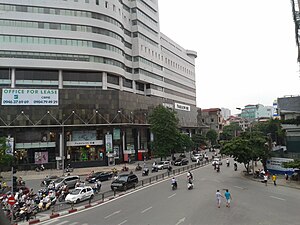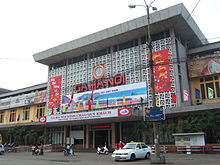Đống Đa district
Dong Da district
Quận Đống Đa | |
|---|---|
 Temple of Literature in Văn Miếu ward | |
 Interactive map outlining Đống Đa | |
| Coordinates: 21°00′49″N 105°49′36″E / 21.01361°N 105.82667°E | |
| Country | |
| Region | Red River Delta |
| Province | Hanoi |
| Seat | Ô Chợ Dừa ward |
| Wards | 21 wards [1] |
| Government | |
| • Secretary of the Party | Hà Minh Hải |
| • Chairman of People's Council | Nguyễn Anh Cường [2] |
| • Chairman of People's Committee | Đặng Việt Quân [2] |
| Area | |
| • Total | 9.95 km2 (3.84 sq mi) |
| Population | |
| • Total | 420,900 [1] |
| Time zone | UTC+7 (ICT) |
| Area code | 24 |
| Climate | Cwa |
| Website | dongda |
Đống Đa (literally Banyan Heap; Vietnamese pronunciation:[ɗəwŋ˧˥ ɗaː˧˧]) is one of the four original urban districts (quận) of Hanoi, the capital city of Vietnam.[3] It is bordered by Ba Đình to the north, Hoàn Kiếm to the northeast, Hai Bà Trưng to the east, Thanh Xuân to the south, and Cầu Giấy to the west. The district currently has 21 wards, covering a total area of 9.95 square kilometers.[1] It is the most populous district in Hanoi. As of 2017,[1] there were 420900 people residing in the district, the population density is 42302 inhabitants per square kilometer, 18 times higher than the overall density of Hanoi. Dong Da district is home to various enterprises and many of Vietnam's most prestigious universities[4] such as Hanoi Medical University, Foreign Trade University, University of Transport and Communications, Thuyloi University.
Dong Da district has a large number of monuments and relics, including Temple of Literature (Văn Miếu), a cultural symbol of the city. The district is also where the Battle of Ngọc Hồi-Đống Đa between Tây Sơn dynasty and the Qing dynasty, one of the greatest victories in Vietnamese military history,[5] ended.[6][7]
Geography[edit]
Đống Đa is located at 21°00' North, 105°49' East, in the center of Hanoi. The district covers an area of 9.95 km2 (3.8 sq mi),[8] bordered by Ba Đình to the north, Hoàn Kiếm to the northeast, Hai Bà Trưng to the east, Thanh Xuân to the south, and Cầu Giấy to the west.[9] Of the land in Đống Đa, 5.00 km2 (1.93 sq mi), or 50.3% is specially used land, while 4.36 km2 (1.68 sq mi), or 43.8%, is used for residential purposes.
Đống Đa has relatively flat terrain,[10] with only a few small mounds in the eastern parts, including Đống Đa Mound.[11]
Lakes[edit]


There are several large lakes such as Ba Mau lake, Kim Lien lake, Xa Dan lake, Dong Da lake, Van Chuong lake.[10] In the past, there used to be many ponds and lagoons; however; but due to social-economic development and urbanization, the number of them has been reduced, with many being filled or polluted.
- Ba Mau Lake
- Dong Da Lake
- Hao Nam Lake, near Cát Linh station of Line 2A, Hanoi Metro
- Nam Dong Lake
- Van Chuong Lake
- Linh Quang Lake
- Khuong Thuong Lake
- Ho Me Lake, located at the corner of the street Ton That Tung - Truong Chinh, next to the Hanoi Medical University
- Lang Lake
- Kim Lien Lake
Administrative divisions[edit]
The district is divided into 21 wards (phường).[1]
|
|
|
Economy[edit]
As of 2015, there are 11169 acting enterprises, cooperatives, and 11133 non-farm individual business establishments in the district.[1] Several of Vietnam's largest companies, such as Petrolimex,[12] Vinacomin,[13] Vietnam Posts and Telecommunications Group,[14] Vietnam Steel Corporation[15] and VPBank,[16][17] are headquartered in this district.
-
Lang Road
-
Thai Ha Street
-
Pham Ngoc Thach Street
-
Nguyen Chi Thanh Street
-
Truong Chinh Street
-
Tay Son Street
Landmarks[edit]
- Hanoi station
- Temple of Literature
- Đống Đa Mound
- Boc Pagoda
- Phuc Khanh Pagoda
- Láng Pagoda
- Thong Nhat Park (Lenin Park)
- Hoang Cao Khai's tomb
Education[edit]
Colleges and universities[edit]
- University of Transport and Communications
- Vietnam Trade Union University
- Hanoi Law University
- Foreign Trade University
- Thuyloi University
- Hanoi Medical University
- Diplomatic Academy of Vietnam
- Banking Academy of Vietnam
- Hanoi University of Industrial Fine Arts
- Hanoi University of Culture
- Vietnam National Academy of Music
- National Academy of Public Administration (Vietnam)
- Vietnam Women's Academy
- Vietnam Youth Academy
Health care and other facilities[edit]
Some medical facilities in Dong Da:
- Bạch Mai Hospital
- Vietnam National Hospital of Acupuncture
- Hôpital Français de Hanoi
- Vietnam National Hospital of Pediatrics
- Hanoi Medical University Hospital
- National Otorhinorarynology Hospital of Vietnam
- National Hospital of Endocrinology
- National Hospital of Dermatology and Venereology
Sports[edit]
Hàng Đẫy Stadium, also known as Hanoi Stadium, is situated in Dong Da district. The stadium holds 22,500 spectators, currently used mostly for football matches.[18] Since the 2009 season, all four of the football clubs in Hanoi – Hanoi FC, Thể Công, Hòa Phát Hà Nội, and Hà Nội ACB – have chosen the stadium as their home ground.
Shopping[edit]
Đặng Văn Ngữ Street
Đông Các Street
Đông Tác SecondHand Market
Chùa Bộc Street
Chùa Láng Street
See also[edit]
References[edit]
- ^ a b c d e f g "Niên giám thống kê tóm tắt 2017". December 31, 2017. Retrieved July 20, 2018.
- ^ a b "Ông Đặng Việt Quân giữ chức Chủ tịch UBND quận Đống Đa". June 25, 2020.
- ^ "Hà Nội có thêm năm quận mới vào năm 2025". VnExpress. 2019-10-30.
- ^ "Hà Nội: Phát triển Đống Đa thành quận có kinh tế tri thức và kinh tế số". Vietnam News Agency. 2020-07-22.
- ^ Tucker, p. 20: "Quang Trung promised to treat humanely all Chinese who surrendered and many did so.53 The Vietnamese know this series of victories as the Victory of Ngọc Hồi-Đống Đa, the Emperor Quang Trung's Victory over the Manchu, or the Victory of Spring 1789. It is still celebrated as the greatest military achievement in modern Vietnamese ..."
- ^ "Nghìn người tham dự lễ hội gò Đống Đa". VnExpress. 2020-01-29.
- ^ Hữu Ngọc (2016). Viet Nam: Tradition and Change. Ohio University Press. ISBN 978-0896804937.
- ^ "Đẩy mạnh đầu tư cơ sở hạ tầng ở quận Đống Đa". Nhân Dân. 2017-03-30.
- ^ "Quận Đống Đa".
- ^ a b "UBND Quận Đống Đa - Hà Nội". Hà Nội Mới.
- ^ Dong Da Mound Dong A, Binh Dinh Newspaper, January 11, 2007
- ^ "About Petrolimex". Petrolimex.com.vn. Retrieved 2016-07-15.
- ^ http://www.vinacomin.vn/.
{{cite web}}: Missing or empty|title=(help) - ^ https://vnpt.vn/.
{{cite web}}: Missing or empty|title=(help) - ^ "Introduction of Parent Company – Viet Nam Steel Corporation".
- ^ "VPBank xin chuyển trụ sở vì nhân sự tăng cao". 30 March 2016.
- ^ "Sau những lận đận, tháp Láng Hạ đã trở thành trụ sở của VPBank".
- ^ "Sân vận động Hàng Đẫy (Hang Day Stadium) - Soccerway".














